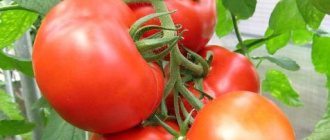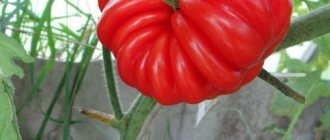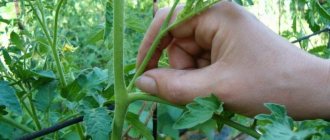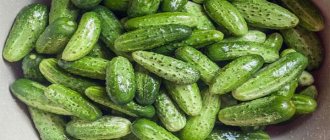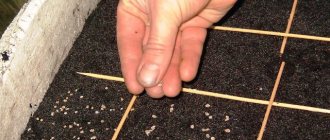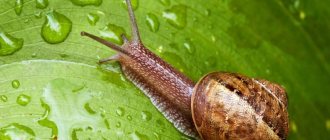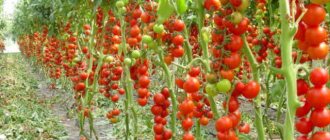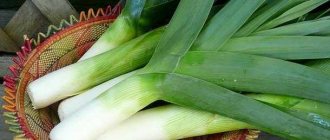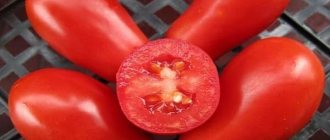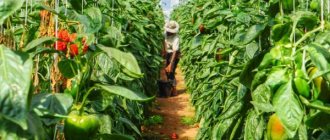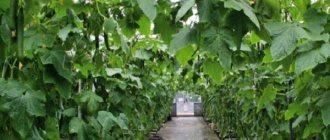Growing tomatoes
Let's look at the main features of growing Raspberry Rhapsody tomatoes.
How to prepare seeds?
For planting, it is necessary to select whole, strong seeds. Experienced vegetable growers recommend disinfecting seeds in a solution of potassium permanganate for several hours. For better germination, the seed should be treated with growth stimulants.
Sowing seed material
HELP: The container with seeds is covered with plastic wrap and placed in a warm place.
It is necessary to sow prepared seeds for seedlings at the end of March. The seeds are placed in containers or other containers filled with soil. Planting material should be sown to a depth of at least 1.5 cm.
When shoots appear, the film is removed and the seedlings are placed in a well-lit room.
After the appearance of two true leaves, the plants are picked.
Rules for planting seedlings
Plants are moved to the greenhouse in mid-May. The soil in the beds must be fertilized with organic matter. Seedlings are planted at a distance of 30-40 cm from each other.
After planting, the seedlings need to be watered with warm water in the evening.
Basic growing rules
In order for the work expended to more than pay off, you need to properly care for the seedlings, and subsequently for the adult specimens.
Rhapsody seed products are most often covered with a shell, but if it is absent, then pre-sowing preparation can be carried out:
- soak for a day in an ash solution (2 tablespoons per 1 liter of warm water);
- Keep in a solution of a growth stimulator (“Zircon” or “Albit”) for 10 hours;
- Keep it on the bottom shelf of the refrigerator for a day.
Sowing seeds is carried out in several stages:
- Fill small boxes or containers with soil mixture (garden soil, humus, peat and sand in equal proportions).
- Water the soil and spread the seeds. Sprinkle the same mixture, sand or peat chips on top (the layer should be no thicker than 1.5 cm).
- Cover the crops with film to speed up germination and reduce moisture evaporation. During germination, it is important to maintain the air temperature at 22... 24°C.
- when seedling hooks appear, the film is removed;
- to prevent the sprouts from stretching, it is necessary to provide lighting for more than 14 hours a day;
- daytime temperature is maintained at 20°C, and night temperature is about 16°C;
- Moderate watering is needed so that the top layer dries out a little (about 2 times a week). When overwatered, there is a risk of blackleg disease;
- After 2 true leaves appear, the seedlings need to be pruned. Plants are planted in separate containers (plastic cups or peat pots), which are filled with soil of the same composition as was used for the previous planting;
- It is not necessary to fertilize the seedlings - they will have enough nutrients before planting in a permanent place;
- two weeks before planting the seedlings, they begin to accustom them to environmental conditions. These procedures are carried out at a temperature of 10°C (not lower). The duration of hardening gradually increases.
We invite you to familiarize yourself with: Strawberry Victoria variety characteristics and agricultural technology
Important! It is of great importance to accustom the seedlings not only to the air temperature, but also to the sun's rays, which are also a great stress for it.
Before transplanting seedlings to a permanent place, you need to consider the following nuances:
- It is important to decide on its placement. Tomatoes love the sun, so you need to choose appropriate areas. It is good to plant tomatoes after cucumbers, onions or carrots. Solanaceae are bad predecessors, as they have common diseases and pests.
- The land should be cultivated twice. In the fall, plant remains are removed, plowing or digging is carried out, and in the spring the beds are dug up with a shovel or pitchfork and harrowed.
- Poor soils should be fertilized. Before autumn treatment, humus (about 5 kg per 1 m²) and mineral fertilizers (40 g of superphosphate 20 g of potassium salt per 1 m²) are added. In the spring, rotted bird droppings and ash (1 kg/m² each), as well as ammonium sulfate (20 g/m²) are added.
Seedlings can be planted in rows opposite each other or in a checkerboard pattern. Basically, the technology is practically no different from planting other varieties and hybrids:
- the distance between bushes is about 0.5 m, and between rows - up to 0.7 m;
- The holes should be larger in size than the earthen ball with roots. A liter of water is poured into each hole;
- the stem needs to be sprinkled with soil slightly higher than it was before, which stimulates additional root formation. Some gardeners even advise cutting off the lower leaves in order to plant the tomato deeper;
- the soil around the seedling needs to be compacted and watered a little more;
- the soil around the stem can be mulched with any suitable material (for example, peat);
- If the sun is too hot, the planted plants need to be shaded.
Growing and proper care
It is necessary to sow seeds for seedlings in early April (approximately 60 days before planting seedlings in open ground). To prevent the bushes from getting tangled and for the roots to have enough space to grow, up to 4 bushes should be planted per square meter. As soon as two leaves appear on the bush, it is necessary to pick the plant.
Important! The soil where the plants will be transplanted should be rich in calcium and vitamins. To do this, humus and fertilizers are added to it.
. Despite the fact that the plant has a powerful stem, it is still recommended to tie it up
Lush bushes need additional feeding. Potassium and phosphorus need to be added to bushes that have begun to actively grow.
Despite the fact that the plant has a powerful stem, it is still recommended to tie it up. Lush bushes need additional feeding. Potassium and phosphorus need to be added to bushes that have begun to actively grow.
Initially, the variety was bred in order to grow it in northern latitudes in greenhouse conditions. This is a heat-loving plant, so in the southern zone it can be grown in open ground, and this will not affect the yield in any way.
Since the Rhapsody variety is a hybrid, it is resistant to various diseases that affect tomatoes. Among parasites, this variety can be affected by slugs. To get rid of them, you need to manually collect shellfish and sprinkle the soil around the bushes with ash or sand. For prevention purposes, it is recommended to loosen the soil and spray the leaves with special mixtures.
Transplanting seedlings and care
The soil in the garden beds must be weeded regularly
Only seedlings that are 60 days old will be ready for transplanting.
It is important that it already has 5-6 well-formed leaves. The plant develops well only in loose and light soil, into which fertilizers in the form of peat and humus are first applied.
For loosening, ordinary river sand is suitable, which can easily be replaced with sawdust.
It is necessary to water the planted seedlings only with warm water. The best temperature is no more than 30 °C. It is recommended to water them no more than once every 2 weeks.
When grown in hot conditions, the optimal frequency is once every 4 days. If the soil is too acidic, it is fertilized with wood ash. To ensure normal growth of tomatoes, it is necessary to use phosphorus and potassium as fertilizers. Fertilizing is carried out 6 times during the entire ripening period.
This variety of tomatoes needs regular weeding. The area must be completely cleared of all weeds. Twice during each season the bushes must be hilled. To prevent rapid evaporation of moisture, the root part of the soil is mulched.
Due to their size, the bushes will need staking, but the plant does not require pruning or pinching. When a shoot grows many fruits or additional shoots, it is usually tied up.
Disease and pest control
The main danger among pests for the Rhapsody F1 variety will be slugs. It won't be difficult to overcome them. These parasites will need to be removed from the plant, and then a special barrier will need to be created. To do this, sprinkle the ground near the bushes with coarse sand or ash.
Tatyana Orlova (Vasilidchenko) (candidate of agricultural sciences):
Collecting slugs with your hands is also a pleasure. There are special means to combat these mollusks: Slug Eater, Thunder, Molluscicide.
Tomatoes have a fairly high resistance to diseases, but the plant could still use a little prevention. Spraying with celandine tincture will not only prevent the development of diseases, but also repel pests. It is better to carry out prevention before flowering.
The spray solution is easy to prepare. You will need to collect 1.5 kg of fresh plant and then fill it with water (8-9 l). A soda solution is suitable as an alternative. For 10 liters of water you will need no more than 300 g of soda. Regular ventilation of the greenhouse will be an excellent prevention of both diseases and pests.
Tatyana Orlova (Vasilidchenko) (candidate of agricultural sciences):
It is much easier to use ready-made biological agents Barrier or Barrier to prevent diseases on tomatoes.
Product of domestic breeders
This type of vegetable was developed by Russian farmers in 2013. The description of the variety indicates that the tomato belongs to the standard type with undeveloped side shoots. Thus, the bushes can be planted compactly without worrying about the appearance of shadows from nearby neighbors
This makes caring for seedlings much easier, which is especially important at first, when the intensive development of side shoots begins.
Raspberry Rhapsody does not require pinching and leaf fragments. But you will still have to tie it up due to the underdeveloped root system and the fragility of the stems.
The height of the bush reaches a maximum of 60 cm. For a home greenhouse, where there is no special lighting, this is an advantageous indicator, since all plants equally receive their share of sunlight. This characteristic of a tomato, such as mass, for the first fruits is 300 g.
As the second and subsequent levels mature, their weight decreases slightly and remains at the level of 200-250 g. The variety is resistant to the harmful effects of fusarium.
Description of fruits:
- Tomatoes have a flattened round shape with strongly protruding ribs of fleshy pulp and 5-6 chambers of cotyledons.
- Dry matter weight reaches 5%.
- The ideal color scheme of tomatoes, reminiscent of raspberries, makes it possible to preserve the fruits.
- They are grown mainly for home use.
- Raspberry Rhapsody is not suitable for mass production due to the insufficient “keeping quality” of the fruit and rapid rotting.
To get high yields of tomatoes on soil not protected from frost, you must do the following:
- mulching the soil with rotted straw;
- one-time fertilizing with mineral and nitrogen fertilizers;
- treatment against pests: garden ants, aphids, snails;
- timely watering.
From 1 m² of area you get up to 15 kg of first-class fruits. Tomatoes are perfectly suited for cultivation in the southern regions of Russia in open ground. Greenhouses and greenhouses are perfect for growing Raspberry Rhapsody in the central zone and northern latitudes.
Description of the Russian tomato Raspberry Rhapsody and growing seedlings
Long before the onset of the new agricultural season, each gardener determines the most profitable varieties of vegetables. One of them is the Raspberry Rhapsody tomato. The plant bears its first fruits already 90 days after the sprouts emerge. It feels great in greenhouses and open ground. A significant disadvantage of the crop is the inability to transport products over long distances.
Product of domestic breeders
This type of vegetable was developed by Russian farmers in 2013. The description of the variety indicates that the tomato belongs to the standard type with undeveloped side shoots.
Thus, the bushes can be planted compactly without worrying about the appearance of shadows from nearby neighbors.
This makes caring for seedlings much easier, which is especially important at first, when the intensive development of side shoots begins. Raspberry Rhapsody does not require pinching and leaf fragments. But you will still have to tie it up due to the underdeveloped root system and the fragility of the stems
But you will still have to tie it up due to the underdeveloped root system and the fragility of the stems
Raspberry Rhapsody does not require pinching and leaf fragments. But you will still have to tie it up due to the underdeveloped root system and the fragility of the stems.
The height of the bush reaches a maximum of 60 cm. For a home greenhouse, where there is no special lighting, this is an advantageous indicator, since all plants equally receive their share of sunlight. This characteristic of a tomato, such as mass, for the first fruits is 300 g.
As the second and subsequent levels mature, their weight decreases slightly and remains at the level of 200-250 g. The variety is resistant to the harmful effects of fusarium.
Description of fruits:
- Tomatoes have a flattened round shape with strongly protruding ribs of fleshy pulp and 5-6 chambers of cotyledons.
- Dry matter weight reaches 5%.
- The ideal color scheme of tomatoes, reminiscent of raspberries, makes it possible to preserve the fruits.
- They are grown mainly for home use.
- Raspberry Rhapsody is not suitable for mass production due to the insufficient “keeping quality” of the fruit and rapid rotting.
To get high yields of tomatoes on soil not protected from frost, you must do the following:
- mulching the soil with rotted straw;
- one-time fertilizing with mineral and nitrogen fertilizers;
- treatment against pests: garden ants, aphids, snails;
- timely watering.
From 1 m² of area you get up to 15 kg of first-class fruits. Tomatoes are perfectly suited for cultivation in the southern regions of Russia in open ground. Greenhouses and greenhouses are perfect for growing Raspberry Rhapsody in the central zone and northern latitudes.
Advantages of the variety, rules for planting seedlings and disease control
Compliance with all agricultural technology conditions will make it possible to obtain up to 5 kg of tomatoes from one bush. The pyramidal planting scheme provides for the placement of 3 bushes per 1 m². Reviews from those who have already tested the new variety over the past few years say that 15 kg of fruit from such an area is a worthy result of the work.
The main advantages of the plant include:
- optimal size;
- attractive appearance;
- good yield;
- friendly formation of the ovary and ripening of fruits;
Experts note the resistance of tomatoes to diseases.
Planting seeds in the soil begins in late March - early April. After the shoots germinate and two true leaves appear, a dive is performed. In early June, when the risk of morning frosts is minimal, seedlings are planted on unprotected soil.
The disadvantage of the culture is its high sensitivity to soil composition. The number of feedings throughout growth and fruiting should be at least five. Tomatoes are demanding on the presence of phosphorus and potassium in the soil.
Tomatoes suffer from blossom end rot and brown spot. The means to combat rot is to reduce the level of nitrogen in the soil and increase calcium. A good result can be achieved by increasing soil moisture and treating damaged bushes with a mixture of calcium nitrate.
To prevent spotting and treat diseased plants it is necessary:
- reduce watering level;
- regularly ventilate the greenhouse;
- maintain a constant temperature.
Tomatoes of this variety have found their niche in home preparations for the winter. Immediately after ripening, they are used as refreshing salads, freshly squeezed juice, spicy ketchup, and vegetable stew.
The meaty consistency allows you to prepare tomatoes in jars.
Vegetables from the first harvest are somewhat large for a glass container, but from the second harvest they are ideal for storing in jars and barrels.
Features of care
Solanaceous crops are thermophilic, so they are extremely difficult to tolerate cold snaps, insufficient watering and drafts. It is necessary to plant plants in a permanent place with a density of no more than 3 - 4 bushes per 1 sq.m of land. During the growth of stems and ripening of tomatoes, the soil must be fertilized with mineral complexes based on potassium and phosphorus.
It is better to tie the bushes at the moment the fruits appear, so that the brushes do not break due to their weight. Mandatory care requirements, in addition to watering and fertilizing, include regular weeding of the site with complete removal of weeds, careful hilling of bushes at least twice a season and mulching of the root part of the soil in order to prevent excessive evaporation of moisture under the influence of direct sunlight.
Variety Golden Rhapsody advantages and disadvantages
Let's consider what positive aspects the variety will please, and what disadvantages are still present in it.
Advantages of "Golden Rhapsody":
- high-yielding variety;
- it is not difficult to grow;
- excellent gastronomic quality indicators. Attracts attention with its appearance;
- fruits set and ripen at the same time;
- plants show resistance to fungal diseases;
- the fruits do not crack.
Disadvantages of the variety:
- fertilizing with fertilizers in large quantities can destroy the plant, so carry out only 2-3 feedings over the entire period;
- The plant is capricious when it comes to watering. It is necessary to irrigate abundantly, but not often;
- Due to their large fruits, they are not suitable for whole canning in jars.
Advantages and disadvantages
Among the main advantages of the variety are the following:
- rich taste of fruits, characterized by a balance of sweetness and acidity;
- high productivity;
- excellent resistance to diseases and pests;
- friendly appearance of the ovary;
- Possibility of growing in any climate, because greenhouse plant;
- unpretentiousness.
The disadvantages of the variety include:
- impossibility of long-term storage of fruits;
- tomatoes do not tolerate transportation well.
- sometimes the plant is capricious in relation to fertilizers or soil.
If you carefully prepare the soil before planting seedlings, the last problem can be easily avoided. Attention should be paid to the selection of fertilizers and fertilizing. If the soil contains all the necessary elements, the plant will not become harmful.
Diseases and pests
There are two types of diseases to which tomatoes of the review variety are susceptible:
- Apical rot;
- Brown spot.
The main method of combating blossom end rot is to reduce the amount of nitrogen in the soil by enriching it with calcium.
In addition, the following methods will help cope with the disease:
- Increasing the humidity of the soil in which tomatoes grow;
- Spraying bushes with calcium nitrate solution.
Brown spotting can be controlled by reducing watering and regularly ventilating greenhouses and greenhouses.
Plants can be harmed by slugs. When gastropods invade, they are collected by hand, and the beds are sprinkled with ground nut shells, pine branches or fine gravel.
Tips for growing tomatoes
To get a good harvest, you need to work hard. Growing a tomato takes all spring and half the summer. Recommendations for growing tomatoes:
- The end of February and the beginning of March, the period during which seeds are planted. The greenhouse or small greenhouse should be well heated. Air temperature +20-25 degrees, humidity not less than 60%.
- Before planting, treat the seed material with a growth stimulator (Epin, Novosil, Kornevin), or soak for 20 minutes. in a 1% solution of potassium permanganate (1 g of potassium permanganate and 100 ml of water).
- Plant the seeds to a depth of 1-2 cm with a distance of 2-3 cm. Water the seedlings with warm, settled water. The seedlings stay in the greenhouse for 50-60 days.
- Grown seedlings are hardened off in 2 weeks. By lowering the air temperature in the greenhouse, the plants gradually get used to the temperature of the open ground.
- 3-4 sprouts are planted per square meter so that the plants do not shade each other and it is convenient to care for them.
- Water the plants with plenty of water. Irrigation frequency is 3-5 days.
- Remove weeds and loosen the soil.
- If pests or diseases appear, take care of the tomato so as not to ruin the harvest.
Important! Tomatoes are most often exposed to diseases: late blight, streak, brown spot. The universal savior of the plant is Bordeaux mixture
To prepare it you will need 100 grams of copper sulfate, 120-150 grams of quicklime, 10 liters. water.
When pests appear, you can use complex preparations: “Calypso” fights aphids, Colorado potato beetles, thrips, cutworms, moths (consumption of 2 ml per 10 liters of water), “Ampligo” will protect plants from: aphids, leaf-eating caterpillars, cutworms, leaf rollers , flower beetles, stem moths (consumption rate 4 ml per 5 liters of water).
Planting and care
To get a high yield of tomatoes in open ground, plants are grown through seedlings. Seeds are soaked before sowing in the immune stimulant Epin. A drop of the drug is diluted in 50 ml of water and the seeds are immersed in the solution for 24 hours. Then the seeds are sown without washing with water.
Immediately after loops appear on the soil surface, the temperature must be reduced. This will prevent the seedlings from being pulled out. Subsequently, the seedlings are kept at a temperature of + 18..+20 degrees.
In open ground, plants are watered, fed and weeded. It is better to mulch the bed with straw or cover it with a thick layer of compost. Under such a coat, the roots do not suffer from overheating or frost.
source
The Rhapsody tomato is a new and interesting plant species of the northern type, which was bred using hybridization. The initial idea was to create a type of tomato that could produce an increased yield in greenhouses. And the breeders succeeded.
Technical features of the Rhapsody tomato
A brief description of the plant includes the following elements of a technical description, important for experienced summer residents who have long been involved in growing various varieties of hybrid varieties:
- early ripeness (ripens in 50-60 days);
- indeterminateness (an endless process of growth);
- tall (the bush stretches up to two meters);
- productivity (with proper care the plant will bear up to 5 kg of fruit);
- medium foliage (small number of leaves).
A distinctive feature of the plant, the Rhapsody F1 tomato, is the hybrid component, visible even in the name of the variety on the packaging. The modest union of a Latin letter and an Arabic numeral indicates that Rhapsody tomatoes are the first generation of a biological union.
Some features of the first generation of hybrid variety:
- Features of the hybrid include resistance to many fungal diseases.
- Rhapsody shows the best results when grown within the walls of a greenhouse; the NK F1 variety is heat-loving; in the southern zone it grows in open ground.
The hybrid combines the best characteristics of its “parents”, being a unique plant with a number of technical features.
Description and characteristics of the variety
The hybrid was included in the State Register in 2001, recommended for cultivation in greenhouses in the third light zone, which includes regions from Belgorod to the Chita region (territories lying south of the 55th parallel).
The hybrid is mid-season, ripens 110-120 days after full germination. The bush is tall with a large number of shoots and leaves, internodes are short. The leaves are abundant, but small, dark green in color.
Inflorescences are formed through three or more leaves. The first is formed over the eighth-ninth. The fruits are spherical, with smooth sides, bright red. There are 2-3 seed chambers. Average weight 150 g, excellent taste.
A distinctive feature of the hybrid Rhapsody F1 is the uniformity of fruit size. Tomatoes are the same in diameter on the bunch itself and on the entire plant.
Planting rules
Typically, seed sowing occurs at the beginning of March and the end of April. The picking process occurs in 2 phases of real leaves. Most often, this type produces only 2-3 stems, but usually only 2.
Many experts recommend sowing 56-65 days before you transplant them directly into the ground. The optimal parameters are to plant no more than 4 plants per 1 m2, maximum 5. If you plant much more, then all the bushes will become entangled with each other and then they may die due to the fact that the roots have nowhere to grow and there is no space. And of course, they will also not have enough fertilizer in the soil.
Also, before planting the seeds, it is necessary to cultivate the soil. Add fertilizer and humus. Even though the plant is a hybrid and can, in principle, grow in almost any soil, vitamins and calcium are still needed. Based on the reviews of many farmers, it can be understood that, even despite the fact that this tomato variety is poorly stored, their yield indicators are still impressive. The first time you can collect more than 10 -15 kg from one bush, subsequent times the figure will fluctuate from 8 kg to 10, sometimes the yield can reach 12 kg.
Description of the variety
The description of the variety is very interesting. Raspberry Rhapsody (the second name of the bush) is a tomato variety that belongs to the carpal type. Carpal type plant - NK - propagation using a brush. It ripens early, has absolutely no limits to growth (indeterminate), and the NK bush gives an excellent and large harvest in greenhouse conditions. In terms of its power and strength, the NK bush is quite strong and can withstand a lot of weight. It is called raspberry because the bush grows tall and has a lot of tomatoes, like raspberries. Tall bushes are not a characteristic feature of tomatoes.
Due to the fact that tomatoes grow profusely on the NK bush, it needs to be tied to some kind of support to help withstand the load on the branch. The best percentage of yield comes from a bush that has only 2–3 stems, sometimes even 1.
"Raspberry Rhapsody" is a relatively new and interesting type of tomato. It can be classified as a fairly early type of variety, since on average 91-96 days pass from the moment of planting to the final result. Such bushes are classified as stamped plants of the determinate type, which, in turn, absolutely do not require such a process as pinching. On average, a bush can grow up to 60-70 cm, but sometimes there are specimens that reach 1 m in height. Basically, this variety is recommended to be stored and grown only in greenhouse conditions and in unprotected soil. Raspberry Rhapsody has a high percentage of resistance to fusarium.
Fruit characteristics
Fruits that have already reached the ripening stage and can already be eaten have a deep red or crimson hue. The fruits are large and round in shape. In addition, the fruits look slightly flattened, and they have large ribbing near the feeding tendril. This variety of tomatoes is suitable for any type of consumption. You can make a tomato from it, eat it fresh, and leave it for dressing. It may be difficult to preserve the fruits whole, since they are large in size, and this will simply be inconvenient.
The pulp of the variety is dense, strong and fleshy. They have a high percentage of strength. As experts say, if you hit the fruit on the ground with all your might, there is a high probability that it will retain its shape, will not be damaged, and will simply jump back. The first fruits you get from the bush can reach 130 grams. and more, since there are not many fruits yet. But further tomatoes will be 50 grams. Less due to the fact that the load on the branch will become greater.
The total number of chambers for this type of variety will be from 4 to 6, and the content of dry substances is 5%. All the fruits that you collect cannot be stored for long, and are quite difficult to tolerate any transportation. It is because of these indicators that not all farmers acquire this species and grow it. In most of the steppe, this variety is suitable for making juices, dressings, etc. Therefore, this type of tomato is usually grown in small quantities.
Characteristic features of the variety
Mid-season tomatoes are grown in greenhouses and open ground. The growing season of ripening from the moment the seed sprouts is 100-110 days. The bushes are of the indeterminate type; upon reaching 1.2-1.5 m, it must be pinched. The foliage of the plant is average.
The fruits are large, 150-300 grams (can reach 400 grams). The shape is flat-round, with slight ribbing at the tail. The variety is yellow-orange in biological ripeness. The skin is thin but dense. The pulp is sweet, fleshy, the seeds are located in small chambers.
With proper care, you can harvest up to 5 kg from one bush. fruits Salad-type tomatoes, suitable for preparing main courses, are an excellent component of pizza. In central and northern Russia, it is recommended to grow in greenhouses. The plant is practically not attacked by fungal diseases.
Detailed characteristics
Rhapsody tomatoes have an early ripening period - they usually take about 100 days. Average yields are 8-12 kg/1 bush, or up to 30-40 kg/m² when planting up to 3-4 plants.
The hybrid is most successfully grown in the southern regions. When cultivating in northern regions, planting in greenhouses is recommended.
External description
The plant is tall, bush type. Height when planted in open ground - up to 2-2.5 m, in a greenhouse - up to 3-3.5 m. Length of internodes - up to 12-15 cm, on a fruit cluster - 7-8 fruits, number of clusters - 8- 10.
The inflorescences are simple, laid on 9-1 leaves, subsequent ones with an interval of 3 leaves.
Fruits weigh 120-140 g, round and flattened shape, the peel is loose, thin, but not prone to cracking, the color at the stage of consumer maturity is bright red, the number of seed chambers is up to 3-4, the number of seeds is insignificant.
Taste
The pulp is fleshy and juicy. Tomatoes have a sour taste. The main purpose is to be consumed fresh, in the preparation of first and second courses, and in the production of juices and sauces. Suitable for whole-fruit canning.
Positive aspects of the variety
Like any variety, Rhapsody has its advantages. The positive aspects outweigh any disadvantages of this type of tomato. Let's look at them in more detail:
- all fruits that grow and ripen have pleasant taste characteristics: you can notice an excellent balance between slight sourness, bitterness and sweetness of the product;
- quite attractive appearance, which increases the percentage of vegetable sales;
- An important advantage of Rhapsody is that it has a high percentage of tomato yield and harvest;
- thanks to the hybridization process, this tomato has good resistance to various diseases and almost never gets sick: one bush can live for a long time in the right greenhouse conditions;
- a good percentage of amicable ovary and characteristics of the maturity of all fruits;
- high percentage of all varietal properties.
The plant is highly resistant to diseases
It should be noted that the system has a fairly strong and persistent immunity, a rather interesting and curious taste of the fruit, and excellent friendly ripening. Many farmers praise this variety for its good resistance to various diseases.
Negative points
The disadvantages of this variety include the fact that it is very poorly stored and can begin to rot after just a few weeks. Sometimes situations were noticed that after just a few days the tomatoes became unusable, and nothing could be done with them.
In addition, sometimes the variety can be capricious. He may not like the composition of the soil and fertilizers that are used. Then it stops growing (if it is a young bush), and if not, then an adult bush can either give a small percentage of the yield, or even wither and cannot be rehabilitated in any way.
Description of the variety
Raspberry Rhapsody is an early tomato variety that produces its first harvest 90 to 95 days after emergence. Refers to determinate standard tomatoes that do not require pinching. The height of the bush does not exceed 60 centimeters. Can be grown both under film cover and in unprotected soil.
The characteristics of the fruit immediately attract attention to the variety. The weight of one tomato reaches 300 grams with good care, the pulp is very dense and fleshy
Dry matter content is 5%. There are about 5 – 6 seed chambers. When ripe, the fruits have a crimson color and a round, slightly flattened shape. Tomatoes are heavily ribbed, which makes their appearance even more presentable and unusual.
Raspberry Rhapsody is almost never grown on an industrial scale, because ripe tomatoes tolerate transportation very poorly and are not suitable for long-term storage: they quickly lose their commercial quality and begin to deteriorate.
But for home use, this variety is simply ideal: both for fresh consumption and for preparing preparations and canning.
The yield of Raspberry Rhapsody is high - up to 15 kilograms of ripe fruits are collected from one square meter. With such indicators, just a few bushes on the plot will provide the whole family with delicious fresh tomatoes.
Pros and cons of a hybrid
- Rhapsody NK F1 is characterized by the following advantages:
- bushes are strong and vigorous;
- high yield and almost simultaneous ripening of berries on the cluster;
- the length of the internodes is up to 15 cm, so the number of brushes is greater than that of other tall hybrids;
- the fruits are the same in size not only within the cluster, but throughout the entire bush;
- the skin is resistant to cracking;
- ripe berries can remain on the bush for a long time without overripening or falling off;
- shows good adaptation to climate change;
- It is resistant to fusarium, brown spot, verticillium and tobacco mosaic.
- But at the same time, the plant also has some disadvantages:
- Since this is a hybrid, it is not possible to prepare seeds yourself, so they need to be purchased annually. Their price is higher than the cost of varietal seeds;
- fruits are not intended for too long transportation;
- pinching and shaping of bushes is necessary;
- During long-term storage, they somewhat lose their original taste.
Distinctive features
Characteristics and description of the tomato variety Rhapsody
In gardener circles, the Rhapsody tomato, a hybrid representative of the garden industry, is often mentioned. The juiciness of the mouth-watering filling is gently complemented by the ease of growing, turning a standard plant into a godsend for novice gardeners. What is the incredible Rhapsody? The tomato, which has won so much love from gardeners, has not only the obvious advantages of simple care.
Technical features of the Rhapsody tomato
A brief description of the plant includes the following elements of a technical description, important for experienced summer residents who have long been involved in growing various varieties of hybrid varieties:
- early ripeness (ripens in 50-60 days);
- indeterminateness (an endless process of growth);
- tall (the bush stretches up to two meters);
- productivity (with proper care the plant will bear up to 5 kg of fruit);
- medium foliage (small number of leaves).
A distinctive feature of the plant, the Rhapsody F1 tomato, is the hybrid component, visible even in the name of the variety on the packaging. The modest union of a Latin letter and an Arabic numeral indicates that Rhapsody tomatoes are the first generation of a biological union.
Some features of the first generation of hybrid variety:
Features of the hybrid include resistance to many fungal diseases. Rhapsody shows the best results when grown within the walls of a greenhouse; the NK F1 variety is heat-loving; in the southern zone it grows in open ground.
The hybrid combines the best characteristics of its “parents”, being a unique plant with a number of technical features.
Pros and cons of the domestic hybrid Rhapsody
The advantages of F1, the description of which is quite numerous and varied, are not limited to hybrid endurance. Sweet tomatoes of the domestic tomato variety have:
High yield level, thin branches generously showered with large fruits. Simple growing processes. Rhapsody is unpretentious and easily copes with unfavorable climate conditions. The visual component of a ripe fruit, a high level of gastronomic qualities. The fruits set and ripen at the same time; a friendly ovary has a positive effect on the quality of ripe tomatoes. Resistance to some fungal diseases and frequent attacks by aphids.
Reading reviews on thematic forums, you can come across some disadvantages of the variety. Summer residents note that the plant can be capricious in relation to:
- soil composition;
- fertilizers;
- water quality.
You cannot be overzealous with the amount of mineral fertilizers; the plant should be fed only 2-3 times during the entire process of its growth. Watering should be plentiful, but not frequent (1-2 times a week).
Culinary nuances of a ripe tomato
Ripe tomatoes have a round shape, a dense peel of a rich red hue, one fruit weighs from 100 to 150 grams. Gastronomic advantages and differences from other varieties:
Bright tomatoes of the Rhapsody variety are not prone to cracking and have a good presentation. Ripe fruits have a taste with barely noticeable sourness. First harvest tomatoes are not suitable for canning.
The hybrid fruits of Rhapsody make excellent sauces and juices; tomatoes fit perfectly into the picture of a dietary salad.
Principles of sowing, basic rules of cultivation
Advice from experienced summer residents, the main rules for caring for the Rhapsody variety plant:
The sowing procedure for smooth seeds takes place in the first weeks of April. Diving must be done when two true leaves appear. It is recommended to form bushes into two stems. Despite its growth, the powerful stem needs garter. Fluffy bushes need fertilizing with complex fertilizers.
At the stage of active growth of the Rhapsody stem, one should not forget about fertilizing with potassium and phosphorus.
Possible pest hazard
The plant may be attacked by slugs; to eliminate parasites it is necessary:
Collect clams by hand. Sprinkle the ground around the NK F1 bushes with ash and coarse sand.
Such machinations create a barrier that protects the trunk from invasions of vile creatures. To prevent diseases, you should spray the leaves with healing mixtures, regularly ventilate the greenhouse, and loosen the soil.
xn—-7sbbncec2cn3hzb.xn--p1ai
Features of cultivation
Among the features of the “Raspberry Rhapsody” tomatoes, many note its strong immunity, interesting taste of ripe tomatoes and friendly ripening. Many also note resistance to diseases.
Sowing seeds in late March - early April. Dive in the phase of two true leaves. Plant bushes form one or two stems, usually two. The plant is small in stature, but needs staking; this will serve as additional protection from bad weather if the tomato grows in open ground.
“Crimson Rhapsody” is picky about the composition of the soil and requires regular fertilizing 4-5 times per season. At the stage of active growth and ovary, it loves fertilizers containing potassium and phosphorus. In the future, the volume of fertilizers is reduced.
Read more on our website all about fertilizers for tomatoes:
- Complex, mineral, organic, ready-made, TOP of the best.
- Foliar, when picking, for seedlings.
- Yeast, iodine, ammonia, boric acid, ash.
Bush care
Due to its relatively large size, the plant must be tied up, especially if the plant lives in an open area where there are often gusts of strong winds. It must be remembered that the bush must be tied up so that it can support the weight of its fruits. There can be up to 5-6 tomatoes on one branch, which means almost 0.5 kg. It is best to take ordinary wooden sticks, place them in the middle of the bush and carefully tie branches to them with a ribbon. Watch carefully so that you do not accidentally crush the fruits of the bush.
This type of tomato does not need pruning, but if you see that there are too many shoots and fruits, you can tie a stick there too. There is no need to remove leaves or anything else on the bush.
It is necessary to water the plant depending on the conditions under which it is kept. If the humidity in the greenhouse is very high, once every 2 weeks is enough, but if, on the contrary, it is too dry, then every 4 days. If standard conditions are maintained, the bushes are watered once a week.
This variety is quite capricious to the soil, so it is necessary to add fertilizer 5-6 times during the ripening season. At the peak of active activity, it is better to add those supplements that contain calcium and phosphorus.
Description of the hybrid tomato Rhapsody and recommendations for growing the plant
Rhapsody is a hybrid tomato variety that was bred not so long ago. This is a rather interesting type of tomato, intended for cultivation in northern latitudes. Initially, it was planned to develop a type of tomato that could increase productivity when grown in greenhouse conditions. The breeders managed to achieve their goal, and summer residents and farmers received a new and very tasty variety of tomato.
What is a Rhapsody tomato?
Characteristics and description of the variety:
- Rhapsody is a raceme tomato, otherwise called NK F1;
- the variety is early ripening and has unlimited bush growth;
- has good productivity;
- the plant is quite powerful and can withstand a large weight load;
- sometimes the variety is called Raspberry Rhapsody - thanks to the large bushes, completely covered with fruits, it resembles a raspberry bush;
- tomato bushes Rhapsody F1 need a garter, this is due to the fact that a large number of fruits grow on them and help is required to hold all this abundance;
- In terms of yield, bushes with 1, 2 or 3 stems are recognized as the best.
On average, it takes about 3 months from planting to harvest. In this case, pinning is not required. 1 bush can reach 70 cm in height, sometimes representatives higher than this figure are found. As a rule, this subspecies of tomatoes is grown in greenhouses and on unprotected soil.
Ripe Rhapsody tomato fruits are bright red or crimson in color. The shape is round, slightly flattened, with ribbing near the stalk; the fruits themselves are quite large. Rhapsody tomatoes are suitable for any further use: fresh, canned or as a sauce.
The variety has fleshy and dense pulp, as well as durable skin. Experts say that even if dropped onto a hard surface from a height of human height, the fruit is able to retain its shape and not receive visible damage. The fruits obtained from the first bush reach 130 g or more in weight due to the small quantity. In the future, when more tomatoes begin to grow, their weight will decrease somewhat.
When describing the variety of fruits, it is worth mentioning long-term storage. Rhapsody cannot retain its properties for a long time; it is not recommended to transport it over long distances. This, as a rule, scares summer residents away from purchasing or forces them to grow small amounts of this representative.
How to grow tomatoes?
Let's look at the growing process. Sowing of seeds is planned for early or mid-spring. Experts recommend sowing seeds 2 months before planting plants in the ground. There should be a maximum of 4 bushes per 1 m², otherwise there is a high risk of confusion between bushes and their death due to the impossibility of root growth.
Before planting, the soil must be prepared by adding fertilizers and humus. The soil should be enriched with vitamins and calcium.
Rhapsody has a number of positive characteristics that greatly exceed all the negative qualities of the variety. Grown and ripened fruits have a good taste: they maintain the ideal balance of sweetness, acidity and bitterness of the product.
Since the Rhapsody F1 tomato is a hybrid, it is practically not susceptible to diseases that usually attack tomatoes.
There are also disadvantages to the Rhapsody tomato. One of them is that a ripe fruit begins to rot within a couple of weeks, in some cases after a few days. The tomato is also capricious in terms of care: it does not always “like” the soil in which it was planted. In addition, the variety is quite picky when it comes to fertilizers.
However, reviews from a large number of farmers indicate that the advantages more than compensate for the negative features of the variety.
Growing tomato Rhapsody
Among all the tomato varieties, one of the most popular is the Rhapsody tomato. Initially, it was bred as a variety capable of producing large yields in greenhouse conditions. The breeders managed to bring the plan to life and obtain tomatoes that can be grown in almost any region, even in the northern ones.
Growing tomato Rhapsody
Description
This variety has another name - golden or crimson Rhapsody. It is called that because the bushes always produce a lot of fruits, like raspberries, and the bushes themselves are tall. This tomato variety is indeterminate.
According to the description, Rhapsody F1 is an early tomato variety. Greenhouse conditions are more suitable for its cultivation. In open ground, the plant may not develop so well and may not produce a large harvest. Rhapsody tomatoes belong to the NK type and are propagated by trusses.
This tomato variety is tall. The bushes grow up to 160-170 cm. In rare cases, they can reach a height of about 2 m.
There are not too many leaves on the bushes. They are dark green in color and small in size. The stems of the plant are strong, capable of supporting a large weight of fruit. Most often the bush has from 1 to 3 main stems.
Fruit
In ripe fruits, the skin is highly durable and has a rich red or crimson hue. Rhapsody tomatoes are large in size and have a round shape. The ribbing is clearly visible on them.
The pulp of the fruit is fleshy and dense in structure. The weight of one tomato is about 130 g. When there are more tomatoes and the load on the stem increases, their weight drops to 50 g.
Characteristic
The description indicates that Raspberry Rhapsody is a tomato variety that has a good level of resistance to mechanical damage.
The variety is resistant to various types of pests and diseases. Their immunity to fusarium is especially strong, but for such a plant it is important to provide the proper conditions, because Even the wrong fertilizer can cause bushes to stop growing normally.
Productivity
The yield indicators of Rhapsody cannot fail to impress. When you first harvest fruits, you can remove up to 15 kg of tomatoes from one bush. In the future, this number will decrease slightly and you can get 8-10 kg of tomatoes from the bush.
On average, the yield will be 12 kg, but provided that 4 bushes are planted per 1 m. If more plants are placed in such an area, this can lead to a significant decrease in yield and even the death of the crop. The reasons for this will be a lack of space for root growth and an insufficient amount of nutrients.
Growing regions
The Rhapsody variety can be grown in almost any region. Initially, it was bred for breeding in the northern territories. In such conditions, tomatoes grow well if planted in greenhouses.
In any other areas this variety takes root well. Since it is a greenhouse plant, it should not be planted in open ground. The only exception will be the southern regions. Here the frosts end early and the climate is warm, so in such conditions the plant will develop well even in open ground.
Area of application of fruits
The fruits are delicious fresh
Tomatoes of this variety are not only consumed fresh, but also canned. However, due to the large size of the fruit as a whole, it will not be so easy to preserve them.
Tomatoes of this variety, according to the description, have high-level taste characteristics, so they make excellent sauces. Juice is also made from the fruits.
Advantages and disadvantages
Among the main advantages of the variety are the following:
- rich taste of fruits, characterized by a balance of sweetness and acidity;
- high productivity;
- excellent resistance to diseases and pests;
- friendly appearance of the ovary;
- Possibility of growing in any climate, because greenhouse plant;
- unpretentiousness.
The disadvantages of the variety include:
- impossibility of long-term storage of fruits;
- tomatoes do not tolerate transportation well.
- sometimes the plant is capricious in relation to fertilizers or soil.
Main characteristics
The growth process of bushes is not limited, therefore, in early July, when a sufficient number of brushes with fruit ovaries have been formed on the plant, it is necessary to carefully pinch the tops. In this way, the nutrients used will be directed to the development and ripening of the fruits themselves, and not to the further growth of the stems. As a rule, bushes are pinched after they reach 1.8 - 2 m in height. The optimal formation of bushes consists of 1 - 2 main stems, so all other side shoots must be pinched.
The hybrid belongs to the category of early ripening plants, since the first harvest can be obtained within 50 - 60 days from the moment the seedlings are planted in a permanent place of growth. The high yield of tomatoes makes it possible to obtain about 4.5 - 5 kg of fruit from one bush, subject to the minimum care requirements. The bushes themselves have an average density of foliage, but the lower rows must be torn off so that the green tops do not come into contact with the ground.
Description of fruits
Ripe tomato fruits have a flat-round shape, a rich red color, a balanced taste with barely noticeable sourness and an average weight of about 110 - 140 g each. At the same time, the thin and dense skin of the fruit prevents possible cracking of the fruit not only during the ripening process, but also after heat treatment. The primary use of ripe tomatoes is fresh. The first harvest is not suitable for canning, but is successfully used in the preparation of juices and sauces. Tomatoes are recommended for use in menus when following diets.
Advantages and disadvantages
An important difference between the Rhapsody hybrid is its resistance to damage by most fungal infections. The list of positive qualities of tomatoes also includes: .
- the absence of any special requirements for growing seedlings and caring for bushes;
- high yield due to the large number of tomatoes on each bush, as well as their large size;
- the harmony of the processes of setting future fruits and their full ripening;
- resistance of bushes to possible damage by aphids.
Among the mandatory nuances of growing a hybrid, it is worth highlighting its demands on:
- appropriate soil composition;
- regularity of applied mineral and organic fertilizers;
- quality and temperature of water used for watering seedlings.
Important! When caring for the Rhapsody hybrid, it is recommended to carry out abundant but not too frequent watering (no more than 2 times a week), and fertilizers are needed only 2 - 3 times during the entire season.
Features of crop care
Caring for tall and low-growing tomatoes is different: since indeterminate (tall) specimens do not have growth restrictions, there are some features when caring for them.
Watering rules
Tomatoes tolerate drought better than waterlogging, which causes poor growth and the occurrence of diseases.
Find out in more detail how to properly water tomatoes in a greenhouse and in open ground.
There are some important points:
- You need to water the plants once a week, spending about a liter of water on each bush;
- in case of rainy weather or drought, certain adjustments are made to the watering schedule;
- The optimal time for watering is considered to be the second half of the day;
- Such procedures are very important when the first clusters bloom;
- before loosening and after fertilizing (dry), tomatoes also need moisture;
- The use of drip irrigation gives good results.
Top dressing
Tomatoes are demanding when it comes to fertilizing, but do not like too much of it.
- If fertilizers were not applied to the soil in the spring, then the first fertilizing is carried out 2 weeks after planting the seedlings. For a bucket of water, take 1 part of mullein (about 1 kg), as well as 20 g of superphosphate. 500 ml of solution is poured under each bush.
- The second feeding is carried out 3 weeks after the first. Dry fertilizers are used for it (20 g of superphosphate, 15 g of potassium salts and 10 g of ammonium nitrate per 1 m²). It can be combined with hilling.
- A third application of fertilizer is not necessary if the foliage on the tomatoes is rich green and the fruits set and ripen well. If there are problems, apply the same drugs as in the second feeding.
Important! An excess of nitrogen fertilizers increases the growth of green mass and inhibits flowering and fruiting. Nitrogen is important during fruit ripening, and potassium is needed to increase sugar content.
Stepping and bush formation
Bushes of indeterminate hybrids need staking and shaping:
- begin tying tomatoes already under 2–4 leaves. The stakes are driven in from the north side, 10 cm from the base of the bush. You can also use trellises for tying;
- the bush is formed into 1 or 2 stems, and all the rest are removed. The stepsons are not broken off to the ground - they leave “stumps” of 1–1.5 cm so that the sleeping buds do not awaken and the growth of new stepsons does not begin;
- the growth of bushes after reaching a height of about 2 m should be limited. To do this, pinch the top - then the nutrients are directed to the ripening of the fruit, and not to the growth of the stem and leaves;
- for hands that are too large and heavy, additional garter may be required;
- If the harvest will be carried out with brushes, then they need to be normalized. It consists in leaving 6–8 ovaries on the inflorescence, and removing the rest.
Loosening the soil and weeding
Tomato bushes, like most plants, prefer loose soil without weeds, therefore:
- weeds must be regularly removed, as they absorb nutrients needed by tomatoes, and also contribute to the settlement and spread of many pests;
- Loosening the soil between rows should be done every 10–15 days. The use of mulching materials will simplify this task and slow down the growth of weeds;
- Tomatoes need hilling to form additional roots. The first is carried out 2 weeks after planting, the second - 20 days after the first. Before starting work, the plants need to be watered well.
Pests and diseases of the hybrid Rhapsody
Since hybrids are genetically resistant to most diseases, they do not need to be treated with chemicals. For example, they are also resistant to aphids, but can be attacked by slugs. To prevent their appearance, the soil is sprinkled with wood ash and sand, and the tomatoes themselves are powdered with ash. If the pests have already appeared, then you need to collect them manually.
The following methods are used for preventive purposes:
- ensuring good ventilation between the bushes (plantings should not be thickened);
- loosening the soil;
- removal of plant residues from the previous harvest;
- can be sprayed with soda solution (200 g per 10 l) or whey (0.5 l per 10 l of water). This will also serve as additional feeding.
Diseases and pests
Of the particularly dangerous lesions of a tomato hybrid, possible attacks by slugs should be highlighted. To combat pests, you must first collect them by hand from the site, and then cover the soil and powder the bushes themselves with sifted wood ash and coarse river sand.
To prevent other diseases, it is necessary to regularly and fully ventilate greenhouse premises, loosen the soil, and also spray the bushes with healing mixtures using a spray bottle. As a preventative measure, a two-day infusion of celandine can be used, for which you need to use at least 1–1.5 kg of fresh crushed herbs per 8–9 liters of water. The simplest spraying option is a soda solution, where 250 - 300 g of dry matter is taken per 10 liters of water.
The first preventive spraying can be carried out only 14 - 18 days after planting the seedlings in a permanent place. In this case, the bushes must be re-treated after a week's break.
